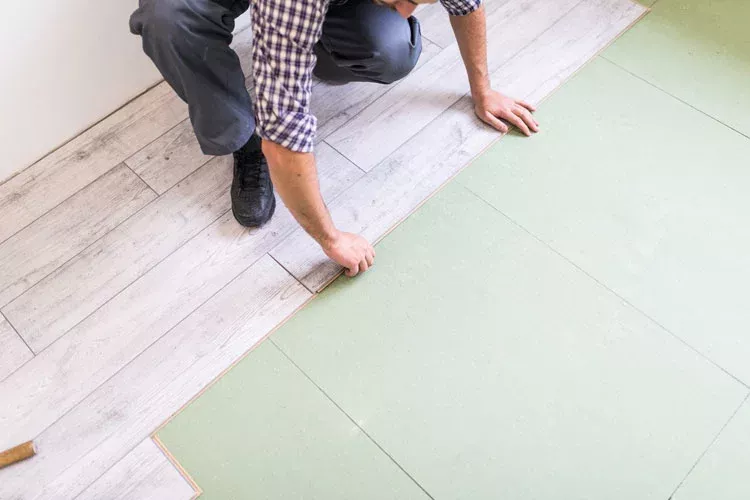
Can Vinyl Flooring Be Installed Over Tile?
Vinyl flooring has become increasingly popular due to its affordability, easy installation, durability, and attractive appearance. But can vinyl flooring be installed over existing tiles? In this article, we’ll explore the benefits of vinyl flooring, when and how it can be installed over tile, potential issues to be aware of, and frequently asked questions on this topic.
The Benefits of Vinyl Flooring
Affordability
One of the main reasons homeowners choose vinyl flooring is its cost-effectiveness. Vinyl is generally less expensive than other flooring options, such as hardwood, tile, or carpet, making it an attractive option for budget-conscious consumers.
Easy Installation
Vinyl flooring is known for its ease of installation. Many types of vinyl can be installed by DIY enthusiasts, saving the cost of professional installation. Furthermore, vinyl flooring can often be installed over existing flooring, reducing the need for demolition and disposal of old materials.
Durability
Vinyl flooring is water- and stain-resistant, making it an excellent choice for high-traffic areas such as kitchens, bathrooms, and hallways. With proper care, vinyl flooring can last many years without showing signs of wear.
Aesthetics
Vinyl flooring comes in a wide variety of colors, patterns, and textures, making it easy to find the perfect design to match your home’s decor. Many vinyl options convincingly mimic the appearance of natural materials, such as wood or stone, without the associated costs or maintenance requirements.
When Can Vinyl Flooring Be Installed Over Tile?
Examining Existing Tile Condition
In some cases, vinyl flooring can be installed over tile, provided the existing tile is in good condition. The tile should be well-adhered, without any loose or damaged pieces. Cracked or chipped tiles can cause problems for the new flooring and should be repaired or replaced before installation.
Assessing Subfloor Stability
The subfloor beneath the tile should be stable, without any signs of movement or damage. A solid and stable subfloor is crucial for the success of the vinyl flooring installation. If the subfloor is unstable, it may need to be reinforced or repaired before installing the vinyl flooring.
How to Prepare Your Tile Floor for Vinyl Installation
Cleaning the Surface
Before installing vinyl flooring over tile, ensure the surface is clean and debris-free. Sweep or vacuum the tile floor, and then use a mild cleaning solution to remove dirt, grease, or residue. Allow the floor to dry completely before proceeding with the installation.
Leveling the Floor
An even surface is essential for successful vinyl installation. Use a long level or straightedge to identify any high or low spots on the tile floor. Use a leveling compound to create a smooth, even surface if necessary. Follow the manufacturer’s instructions for proper application and drying times.
Filling Grout Lines
For a more uniform surface, it’s essential to fill in any grout lines between the tiles. Apply a grout line filler or a floor leveling compound to the grout lines, ensuring a smooth transition between the tiles. Allow the filler to dry as per the manufacturer’s recommendations before proceeding.
Vinyl Flooring Installation Methods
There are several methods for installing vinyl flooring over tile, each with advantages and disadvantages. Here, we’ll explore three standard installation methods:
Peel-and-Stick Vinyl Tiles
Peel-and-stick vinyl tiles are an easy DIY option for homeowners. They come with an adhesive backing, which makes installation a breeze. Simply remove the protective backing and press the tile firmly onto the prepared surface. Remember that the adhesive may not adhere as effectively to a tile surface as it would to a wood or concrete subfloor.
Floating Vinyl Planks
Floating vinyl planks are another popular choice for installing over tile. These planks connect with a click-lock system, creating a floating floor that does not need to adhere to the subfloor. This method is beneficial for covering uneven tile surfaces, as the floating floor can accommodate minor variations in height.
Glue-Down Vinyl Flooring
Glue-down vinyl flooring is a more permanent option that requires adhesive to secure the vinyl to the subfloor. This method is best suited for professional installation, as it can be more challenging for DIYers. Glue-down vinyl flooring provides a more stable and durable surface than floating or peel-and-stick options.
Potential Issues with Installing Vinyl Over Tile
While installing vinyl flooring over tile is possible in some cases, it’s essential to be aware of potential issues that may arise:
Height Difference
Adding vinyl flooring on top of existing tile can result in a height difference between rooms or at doorways. This may require the use of transition strips or adjustments to doors to ensure a smooth transition between areas.
Uneven Surfaces
As mentioned earlier, uneven surfaces can cause problems with vinyl flooring installation. If the tile surface is not adequately prepared, it can lead to an uneven, unstable vinyl floor that may wear out prematurely or even become a tripping hazard.
Warranty Considerations
Some vinyl flooring manufacturers may not honor their warranty if the product is installed over existing tile. Be sure to review the warranty information and consult with the manufacturer if you have concerns about warranty coverage.
Frequently Asked Questions
Q1: Can I install vinyl flooring over any tile?
Vinyl flooring can be installed over most types of tile, provided the tile is in good condition, and the subfloor is stable. However, it’s essential to check the manufacturer’s recommendations for your specific vinyl flooring product.
Q2: Can I install vinyl flooring over a heated tile floor?
Some vinyl flooring products can be installed over heated tile floors, but it’s essential to check the manufacturer’s recommendations for temperature limits and installation procedures. Excessive heat may cause some vinyl flooring to warp or become damaged.
Q3: How do I maintain my vinyl flooring installed over tile?
Maintain your vinyl flooring by regularly sweeping or vacuuming to remove dirt and debris. Use a damp mop with a mild cleaner for a more thorough cleaning. Avoid harsh chemicals or abrasive cleaning tools, as they may damage the vinyl surface.
Q4: Can I remove the vinyl flooring if I want to return to the original tile?
Depending on the installation method used, it may be possible to remove the vinyl flooring and reveal the original tile. Peel-and-stick vinyl tiles and floating vinyl planks can typically be removed without causing significant damage to the underlying tile. However, glue-down vinyl flooring may be more challenging to remove without damaging the tile.
Q5: How do I know if my existing tile is suitable for vinyl flooring installation?
To determine if your existing tile is suitable, check for any loose, damaged, or uneven tiles. The tile should be well-adhered and in good condition, with a stable subfloor. If you’re unsure about your tile’s suitability, consult a flooring professional for guidance.
Conclusion
While vinyl flooring can be installed over tile in certain circumstances, it’s crucial to ensure proper preparation and installation methods are used. By assessing the existing tile’s condition, leveling the surface, and choosing the appropriate installation method, homeowners can successfully install vinyl flooring over tile for a beautiful, durable, and cost-effective flooring solution.









